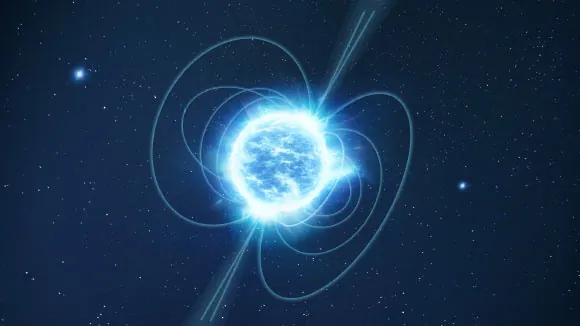
Mystery in the Milky Way: A Runaway Magnetar's Shocking Origins Revealed!
2025-04-15
Author: Daniel
A Magnetar Like No Other!
Astronomers are buzzing with excitement over the discovery of SGR 0501+4516, a peculiar magnetar that defies traditional theories of stellar evolution. This enigmatic celestial body offers a tantalizing glimpse into the mechanisms behind the universe’s most violent phenomena, including the elusive fast radio bursts.
What Makes Magnetars Unique?
Magnetars are a special type of neutron star, known for their extraordinarily powerful magnetic fields that can warp the fabric of space itself. Dr. Ashley Chrimes from the European Space Research and Technology Center describes them as “stars composed entirely of neutrons.” But what sets SGR 0501+4516 apart from its counterparts?
Intriguing Discoveries Using Cutting-Edge Technology
Unveiled in 2008 by NASA’s Swift Observatory, SGR 0501+4516 was initially thought to be a product of a supernova explosion, given its proximity to a supernova remnant known as HB9. However, ten years of meticulous observations using the Hubble Space Telescope and ESA’s Gaia spacecraft have challenged that notion.
The Search for Origin: Conclusive Findings?
Thanks to Hubble's unparalleled sensitivity, astronomers have been able to track SGR 0501+4516's subtle movements across the night sky, pinpointing its position to an accuracy smaller than a single pixel. Unlike conventional magnetars, the calculated path of SGR 0501+4516 reveals no association with any nearby supernova remnants, suggesting that this magnetar’s origin story is far more complex.
Alternative Theories of Formation!
If SGR 0501+4516 was not birthed from a supernova, it raises significant questions about its age and formation. Researchers speculate that it may be older than its predicted 20,000-year age, or it could have formed through one of two fascinating processes: the merger of two lower-mass neutron stars or a phenomenon known as accretion-induced collapse. In the latter scenario, a white dwarf, a remnant of a sun-like star, might draw in material from a companion star, eventually growing too heavy to support itself and collapsing into a neutron star.
Connecting the Dots: Fast Radio Bursts!
Interestingly, the potential formation of magnetars like SGR 0501+4516 through this alternative process might illuminate some mysteries surrounding fast radio bursts. These brief yet intense flashes of radio energy have baffled scientists, particularly those originating from older stellar populations that couldn’t possibly produce the energetic events as seen in younger star systems.
The Bigger Picture in Astrophysics!
Dr. Nanda Rea, an astronomer from the Institute of Space Sciences in Barcelona, emphasized the importance of understanding magnetar formation rates, stating, "These questions go to the heart of high-energy astrophysics, influencing some of the universe's most explosive events." The implications of this research stretch far beyond a single celestial object, potentially reshaping our understanding of magnetars and their role in cosmic phenomena.
Published Findings in Astronomy & Astrophysics
The groundbreaking revelations surrounding SGR 0501+4516 have been documented in the prestigious journal Astronomy & Astrophysics, paving the way for further exploration into the wildest extremes of our universe!


 Brasil (PT)
Brasil (PT)
 Canada (EN)
Canada (EN)
 Chile (ES)
Chile (ES)
 Česko (CS)
Česko (CS)
 대한민국 (KO)
대한민국 (KO)
 España (ES)
España (ES)
 France (FR)
France (FR)
 Hong Kong (EN)
Hong Kong (EN)
 Italia (IT)
Italia (IT)
 日本 (JA)
日本 (JA)
 Magyarország (HU)
Magyarország (HU)
 Norge (NO)
Norge (NO)
 Polska (PL)
Polska (PL)
 Schweiz (DE)
Schweiz (DE)
 Singapore (EN)
Singapore (EN)
 Sverige (SV)
Sverige (SV)
 Suomi (FI)
Suomi (FI)
 Türkiye (TR)
Türkiye (TR)
 الإمارات العربية المتحدة (AR)
الإمارات العربية المتحدة (AR)